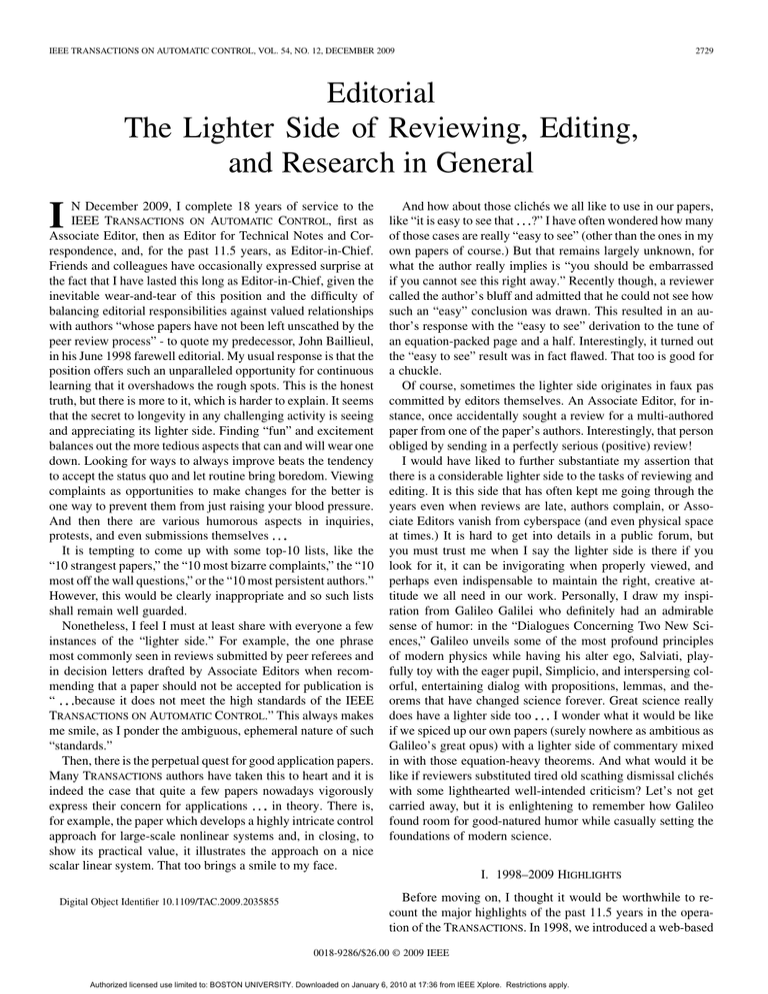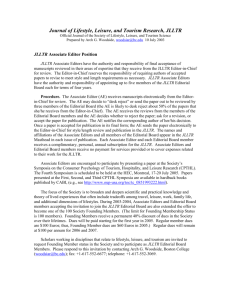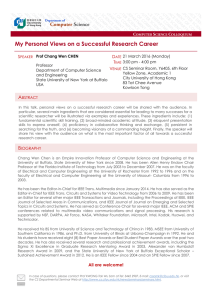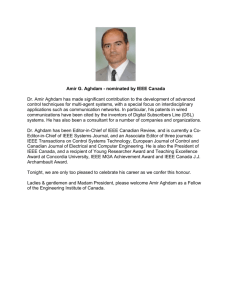I Editorial The Lighter Side of Reviewing, Editing, and Research in General
advertisement

IEEE TRANSACTIONS ON AUTOMATIC CONTROL, VOL. 54, NO. 12, DECEMBER 2009 2729 Editorial The Lighter Side of Reviewing, Editing, and Research in General I N December 2009, I complete 18 years of service to the IEEE TRANSACTIONS ON AUTOMATIC CONTROL, first as Associate Editor, then as Editor for Technical Notes and Correspondence, and, for the past 11.5 years, as Editor-in-Chief. Friends and colleagues have occasionally expressed surprise at the fact that I have lasted this long as Editor-in-Chief, given the inevitable wear-and-tear of this position and the difficulty of balancing editorial responsibilities against valued relationships with authors “whose papers have not been left unscathed by the peer review process” - to quote my predecessor, John Baillieul, in his June 1998 farewell editorial. My usual response is that the position offers such an unparalleled opportunity for continuous learning that it overshadows the rough spots. This is the honest truth, but there is more to it, which is harder to explain. It seems that the secret to longevity in any challenging activity is seeing and appreciating its lighter side. Finding “fun” and excitement balances out the more tedious aspects that can and will wear one down. Looking for ways to always improve beats the tendency to accept the status quo and let routine bring boredom. Viewing complaints as opportunities to make changes for the better is one way to prevent them from just raising your blood pressure. And then there are various humorous aspects in inquiries, protests, and even submissions themselves It is tempting to come up with some top-10 lists, like the “10 strangest papers,” the “10 most bizarre complaints,” the “10 most off the wall questions,” or the “10 most persistent authors.” However, this would be clearly inappropriate and so such lists shall remain well guarded. Nonetheless, I feel I must at least share with everyone a few instances of the “lighter side.” For example, the one phrase most commonly seen in reviews submitted by peer referees and in decision letters drafted by Associate Editors when recommending that a paper should not be accepted for publication is because it does not meet the high standards of the IEEE “ TRANSACTIONS ON AUTOMATIC CONTROL.” This always makes me smile, as I ponder the ambiguous, ephemeral nature of such “standards.” Then, there is the perpetual quest for good application papers. Many TRANSACTIONS authors have taken this to heart and it is indeed the case that quite a few papers nowadays vigorously in theory. There is, express their concern for applications for example, the paper which develops a highly intricate control approach for large-scale nonlinear systems and, in closing, to show its practical value, it illustrates the approach on a nice scalar linear system. That too brings a smile to my face. Digital Object Identifier 10.1109/TAC.2009.2035855 And how about those clichés we all like to use in our papers, like “it is easy to see that ?” I have often wondered how many of those cases are really “easy to see” (other than the ones in my own papers of course.) But that remains largely unknown, for what the author really implies is “you should be embarrassed if you cannot see this right away.” Recently though, a reviewer called the author’s bluff and admitted that he could not see how such an “easy” conclusion was drawn. This resulted in an author’s response with the “easy to see” derivation to the tune of an equation-packed page and a half. Interestingly, it turned out the “easy to see” result was in fact flawed. That too is good for a chuckle. Of course, sometimes the lighter side originates in faux pas committed by editors themselves. An Associate Editor, for instance, once accidentally sought a review for a multi-authored paper from one of the paper’s authors. Interestingly, that person obliged by sending in a perfectly serious (positive) review! I would have liked to further substantiate my assertion that there is a considerable lighter side to the tasks of reviewing and editing. It is this side that has often kept me going through the years even when reviews are late, authors complain, or Associate Editors vanish from cyberspace (and even physical space at times.) It is hard to get into details in a public forum, but you must trust me when I say the lighter side is there if you look for it, it can be invigorating when properly viewed, and perhaps even indispensable to maintain the right, creative attitude we all need in our work. Personally, I draw my inspiration from Galileo Galilei who definitely had an admirable sense of humor: in the “Dialogues Concerning Two New Sciences,” Galileo unveils some of the most profound principles of modern physics while having his alter ego, Salviati, playfully toy with the eager pupil, Simplicio, and interspersing colorful, entertaining dialog with propositions, lemmas, and theorems that have changed science forever. Great science really I wonder what it would be like does have a lighter side too if we spiced up our own papers (surely nowhere as ambitious as Galileo’s great opus) with a lighter side of commentary mixed in with those equation-heavy theorems. And what would it be like if reviewers substituted tired old scathing dismissal clichés with some lighthearted well-intended criticism? Let’s not get carried away, but it is enlightening to remember how Galileo found room for good-natured humor while casually setting the foundations of modern science. I. 1998–2009 HIGHLIGHTS Before moving on, I thought it would be worthwhile to recount the major highlights of the past 11.5 years in the operation of the TRANSACTIONS. In 1998, we introduced a web-based 0018-9286/$26.00 © 2009 IEEE Authorized licensed use limited to: BOSTON UNIVERSITY. Downloaded on January 6, 2010 at 17:36 from IEEE Xplore. Restrictions apply. 2730 IEEE TRANSACTIONS ON AUTOMATIC CONTROL, VOL. 54, NO. 12, DECEMBER 2009 system for submitting, processing, reviewing, and editing papers. This was officially launched in 1999. To the best of my knowledge, the IEEE TRANSACTIONS ON AUTOMATIC CONTROL was the first IEEE journal to institute such a system; it was entirely home-grown, designed by its Editor-in-Chief with the help of a few graduate students at Boston University during their spare time. This served us well until a couple of years ago, when it became clear that a professionally developed and maintained system was necessary to keep up with new features, continuous improvements, and the sheer volume of the papers being processed. Speaking of volume, in 1998 there were 263 Full Paper and 506 Technical Note submissions. In 2007 the number of Full Paper submissions reached 500 for the first time in the history of the TRANSACTIONS and the number of Technical Note submissions was 601. This was the result of a steadily increasing submission volume throughout this decade, an increase that continues to this day. By the end of 2009, there will be well over 700 Full Paper submissions for the year and more than 1500 total submissions. Launched in January 2008, our current manuscript submission and review system, known as the TRANSACTIONS ON AUTOMATIC CONTROL ONLINE (TACO), was developed by Huibert Kwakernaak and Pradeep Misra following the structure of similar web-based paper processing systems like Pampus and PaperPlaza. Unlike many other journals, we elected to work with a customized reviewing and editing environment conforming to the principles based on which the TRANSACTIONS have operated through the years. Even so, it has been extremely challenging to maintain the “high standards of the IEEE TRANSACTIONS ON AUTOMATIC CONTROL” in the face of the overwhelming numbers of submissions we now process. To meet this challenge, a change in the Editorial Board structure was made in early 2009. Four Senior Editors started sharing with the Editor-in-Chief the responsibility of processing all papers, while the positions of Editor for Technical Notes and Correspondence and of Associate Editors-at-Large were eliminated. The number of Senior Editors has since increased by two. Nonetheless, the overall size of the Editorial Board has remained largely unchanged, reflecting the extremely high degree of selectivity that applies to this group. There are currently 35 Associate Editors on the Board, with a plan to increase this number to 38 in 2010. Despite the relatively small size of our Editorial Board and the dramatic increase in submissions, it is remarkable that our reviewing time (from submission to first decision) statistics actually show a decrease since the late 1990s to an average of approximately six months consistently maintained over the past several years. Even more remarkable is the fact that for papers submitted during 2008, this average has in fact further dropped! As for our backlog (the time for a paper to appear in print after it has been officially accepted for publication), it used to be about 12 months in 1998. This was reduced to four months by 2004 and is currently about eight months. Maintaining such low backlogs has come at the expense of increasing the number of pages the Control Systems Society now annually budgets for our journal. For those who keep track of metrics such as “impact factors,” the TRANSACTIONS currently ranks 8th among 206 journals in Electrical and Electronic Engineering according to the latest Journal Citation Report from Thomson ISI. The TRANSACTIONS rank 1st within the same group in terms of the total number of citations. II. THANKS AND FAREWELL One cannot overemphasize the fact that this journal could never exist and operate as it does without those who have selflessly devoted time and effort over the years and those who continue to do so at present. I feel personally indebted to all my predecessors for having established such an outstanding publication vehicle for our community and having sustained it through more than four decades, before I had the privilege to become its Editor-in-Chief. For the record, the table below lists all the Editors-in-Chief of the TRANSACTIONS to date and their tenure periods. Editors-in-Chief, IEEE TRANSACTIONS ON AUTOMATIC CONTROL George S. Axelby May 1956 October 1968 John B. Lewis December 1968 December 1970 Jose B. Cruz February 1971 April 1973 Jerry M. Mendel June 1973 February 1975 Stephen Kahne April 1975 December 1978 Michael K. Sain February 1979 May 1983 Abraham H. Haddad June 1983 December 1988 N. Harris McClamroch January 1989 June 1992 John Baillieul July 1992 June 1998 Christos G. Cassandras July 1998 December 2009 Special words of gratitude must go to John Baillieul who not only helped me in making the transition to Editor-in-Chief in 1998, but also continued to serve the TRANSACTIONS as Associate Editor-at-Large until earlier this year. During the first part of my tenure, I had the pleasure of working with Andre Tits as the Editor for Technical Notes and Correspondence, and since 2005 with Roberto Tempo who replaced him in this position and stepped down earlier this year. I am grateful to both of them. And of course a big “thank you” goes to all Associate Editors and Associate Editors-at-Large who have served on the Editorial Board over the past 12 years and have shared with me some of the experiences I have described as the “lighter side.” Some of them, I am sure, know very well what I am talking about. Panos Antsaklis currently holds the title of Editor-Elect and will take over as Editor-in-Chief in January 2010. Panos and I have worked together over the past year to make the transition to the new editorial structure (mentioned earlier) a smooth one Authorized licensed use limited to: BOSTON UNIVERSITY. Downloaded on January 6, 2010 at 17:36 from IEEE Xplore. Restrictions apply. IEEE TRANSACTIONS ON AUTOMATIC CONTROL, VOL. 54, NO. 12, DECEMBER 2009 and to explore a variety of ways to further improve the operation of the TRANSACTIONS in an era of unprecedented submission numbers and expectations for rapid manuscript turnaround times. With Panos’s leadership, the future of the journal is in the best possible hands. I also believe he is someone who can see the lighter side of things and I hope he does Finally, I am indebted to Cheryl Stewart, my assistant at the TRANSACTIONS Editorial Office for the past 12 years, who has 2731 been tireless, efficient, and always there when I have needed her help. for now. It’s time for me to sign off CHRISTOS G. CASSANDRAS, Editor-in-Chief IEEE Transactions on Automatic Control Authorized licensed use limited to: BOSTON UNIVERSITY. Downloaded on January 6, 2010 at 17:36 from IEEE Xplore. Restrictions apply.





